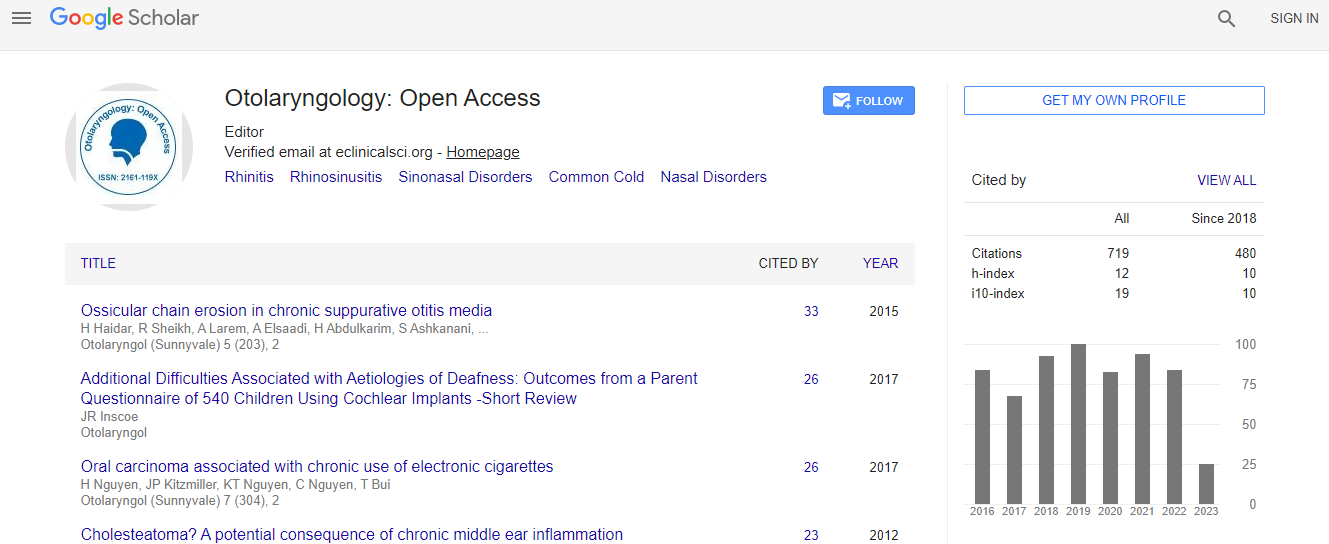Our Group organises 3000+ Global Conferenceseries Events every year across USA, Europe & Asia with support from 1000 more scientific Societies and Publishes 700+ Open Access Journals which contains over 50000 eminent personalities, reputed scientists as editorial board members.
Open Access Journals gaining more Readers and Citations
700 Journals and 15,000,000 Readers Each Journal is getting 25,000+ Readers
Google Scholar citation report
Citations : 925
Otolaryngology: Open Access received 925 citations as per Google Scholar report
Otolaryngology: Open Access peer review process verified at publons
Indexed In
- Index Copernicus
- Google Scholar
- Sherpa Romeo
- Open J Gate
- Genamics JournalSeek
- RefSeek
- Hamdard University
- EBSCO A-Z
- OCLC- WorldCat
- Publons
- Geneva Foundation for Medical Education and Research
- ICMJE
Useful Links
Recommended Journals
Related Subjects
Share This Page
A comparison between HPV positive and negative cervical disease in head and neck squamous cell carcinoma
5th Global Summit and Expo on Head, Neck and Plastic Surgery
Adal Mirza, Gareth Thomas and Emma King
University of Southampton, UK
ScientificTracks Abstracts: Otolaryngol (Sunnyvale)
Abstract
Introduction & Aim: Lymph node metastasis in Head and Neck Squamous Cell Carcinoma (HNSCC) is common at the time of presentation. Prior to the advent of Human Papilloma Virus (HPV)-driven disease, regional metastasis was associated with poor prognosis, but today advanced HPV(+) disease as per the Tumor Nodes Metastasis (TNM) classification, demonstrates a different natural history with improved responses to treatment and 5-year survival. This is a retrospective review of patients undergoing neck dissection for HNSCC and demonstrates remarkable discrepancies in outcomes between HPV(+) and HPV(-) disease. Methods: Ethical approval was obtained (UKCRN 8130; ISRCTN 71276356; and REC references 09/H0501/90 and 07/Q0405/1). 662 patients diagnosed with HNSCC were retrospectively identified. HPV-status was determined using a combination of p16 immunohistochemistry and HPV in situ hybridization; 131 patients were HPV(+) and 531 HPV(-). 337 patients underwent neck dissection and were included in the study. Results: HPV(+) disease demonstrated better overall survival than HPV(-) disease. Extracapsular spread (ECS) was seen in 44.1% of HPV(+) cohort, but had no effect on overall survival (OS) (p=0.269, HR 0.99). Contrarily, 18.9% of the HPV(-) cohort had evidence of ECS and this had a detrimental effect on OS (p=0.027, HR 1.9). In the HPV(+) cohort, a mean of 4 positive nodes were harvested, in comparison to 1.5 in HPV(-) patients (p=0.005). Five or more positive nodes were found to be significantly correlated with poor OS in HPV(+) disease (p<0.001). Conclusion: We show that the presence of ECS is only linked with a poor outcome in patients who are HPV(-). Our data also demonstrates that number of positive nodes is linked to survival.Biography
Adal Mirza is an Otolaryngology Trainee based in the United Kingdom with an interest in Head and Neck Surgery. He is currently pursuing higher degree in HPV related Head and Neck Cancer at the University of Southampton, UK.
Email: mirzaadal@gmail.com

 Spanish
Spanish  Chinese
Chinese  Russian
Russian  German
German  French
French  Japanese
Japanese  Portuguese
Portuguese  Hindi
Hindi 
